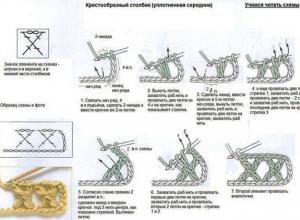How to calculate a woman's ideal weight online. BMI (body mass index) calculator: calculate for men and women
Ideal weight is an average standard that is calculated based on data from a large number of people. But all people are different. Lifestyle, food culture, nationality and body type - all this influences ideal weight. For example, the normal weight of people with a strong physique will be 2-3% higher than that of people with an average build. And the norm for thin people is 3-5% less. Therefore, it is not necessary to strive specifically for the ideal weight, which shows weight calculator. It is quite enough if your weight falls within the calculated range.
Besides weight calculator calculates BMI- body mass index (ideal weight), which is widely used to determine the degree of correspondence between body weight and height.
How to calculate your ideal weight (BMI) yourself
BMI = M: P 2, where
M – body weight in kg
P – height in meters
Example of calculating body mass index: M (weight) – 78 kg, P (height) – 1.68 m
BMI = 78: 1.68 2 = 27.6
From the table below you can see that BMI=27.6 corresponds to overweight.
Interpretation table for BMI indicators
In case of a strong deviation from the norm, it is time to seriously think about correcting your weight. With reduced weight, dystrophy develops. In the modern civilized world, its cause is usually deliberate malnutrition. The desire to have an unnaturally slim figure can result in problems with both mental and physical health - decreased ability to work, dry skin, and hair loss. All this comes from a lack of substances necessary for the body.
However, their excessive excess also does not lead to anything good. A huge number of people suffer from obesity. Excess weight greatly increases the risk of kidney and gallstones, joint deformation, impotence, myocardial infarction and many other diseases. The entire body works under overload, moving masses of fat in space that are not provided for by the design of the human body. It is not surprising that the life expectancy of obese people is on average 6-8 years less than that of others.
Knowing whether your weight is within a normal body weight helps you understand your body, identify problems, and sometimes even make an immediate diagnosis. Body weight control is considered the most important preventive measure for a number of dangerous diseases.
Unfortunately, body weight often worries not the people it should worry about (obese patients), but young girls who have gotten it into their heads that they do not meet the television and magazine standards of 90-60-90, and who drive themselves to fainting with all sorts of diets . In the case of a serious illness, such as diabetes, starvation and semi-starvation diets pose a threat to life.
Therefore, let's together determine whether your weight is normal. Take a notepad and pen, or better yet, a calculator, and we’ll do the math. The procedure for calculating normal weight is quite simple and does not take much time.
Many formulas are used to determine normal body weight. The simplest and most famous:
M = P - 100, where M is mass in kg; P - height in cm.
But this formula in this form is very inaccurate and is applicable only for very rough calculations.
It is advisable to use the full formula (see table below).
Calculation of ideal body weight
| Height, cm | Ideal weight, kg |
| 155-165 | height minus 100 |
| 166-175 | height minus 100 |
| 176-185 | height minus 110 |
| 186+ | height minus 115 |
You can also use a modified formula: ideal body weight = (height in cm minus 100) and another minus 10% - for men; BMI = (height in cm minus 100) and another minus 15% - for women:
- 1 degree of obesity - actual body weight exceeds ideal by less than 30%;
- 2 degree of obesity - if the actual weight exceeds the ideal weight by 31-50%;
- 3 degree of obesity - if the actual weight exceeds the ideal weight by 51-99%;
- 4th degree of obesity - if the actual weight exceeds the ideal weight by as much as 100% or more.
Currently, in most countries of the world, the body mass index (BMI), or Quetelet index, is used to determine normal and overweight in a person:
BMI = M/P 2, where M is weight in kg; P 2 - height in meters squared.
According to the international classification, the norm is considered to be from 18.5 to 24.9 kg/m2. A reading below 18.5 indicates underweight. If the BMI is between 25 and 29.9, it is overweight, and obesity is diagnosed with a BMI over 30.
For example, your height is 181 cm, weight is 99 kg. Let's do a simple calculation: 1.81 2 = 3.2761. Divide 99 by 3.2761, we get BMI = 30.22, which means you are one of the many who have problems with weight:
- 1 degree of obesity (mild obesity) - with a BMI between 27 and 35;
- 2 (moderate) - with a range of values 35-39.9;
- 3 (severe or painful) - with a BMI of 40 or more.
Table of normal human body weight by age
| Height, cm | Person's age, years | |||||||||
| 20-30 | 30-40 | 40-50 | 50-60 | 60+ | ||||||
| M | AND | M | AND | M | AND | M | AND | M | AND | |
| 150 | 53 | 48 | 57 | 51 | 60 | 54 | 60 | 54 | 58 | 52 |
| 152 | 54 | 49 | 58 | 52 | 60 | 54 | 61 | 55 | 59 | 53 |
| 154 | 55 | 51 | 58 | 52 | 61 | 55 | 61 | 55 | 60 | 54 |
| 156 | 57 | 52 | 59 | 53 | 61 | 55 | 62 | 56 | 61 | 55 |
| 158 | 58 | 53 | 59 | 53 | 62 | 56 | 63 | 57 | 62 | 56 |
| 160 | 59 | 54 | 61 | 55 | 63 | 57 | 64 | 58 | 63 | 57 |
| 162 | 61 | 56 | 62 | 56 | 64 | 58 | 65 | 59 | 65 | 58 |
| 164 | 62 | 57 | 63 | 57 | 66 | 59 | 67 | 60 | 66 | 59 |
| 166 | 63 | 58 | 65 | 58 | 67 | 60 | 68 | 61 | 67 | 60 |
| 168 | 65 | 59 | 66 | 59 | 68 | 61 | 70 | 63 | 69 | 62 |
| 170 | 66 | 60 | 68 | 61 | 70 | 63 | 71 | 64 | 71 | 64 |
| 172 | 68 | 61 | 69 | 62 | 72 | 65 | 73 | 66 | 73 | 66 |
| 174 | 69 | 63 | 71 | 64 | 73 | 66 | 75 | 67 | 75 | 67 |
| 176 | 71 | 64 | 73 | 65 | 75 | 68 | 76 | 69 | 77 | 69 |
| 178 | 72 | 65 | 74 | 67 | 77 | 69 | 78 | 71 | 79 | 71 |
| 180 | 74 | 67 | 76 | 68 | 79 | 71 | 80 | 72 | 81 | 73 |
| 182 | 78 | 70 | 78 | 70 | 81 | 73 | 82 | 74 | 83 | 75 |
| 184 | 79 | 71 | 80 | 72 | 83 | 75 | 84 | 76 | 85 | 76 |
| 186 | 81 | 73 | 82 | 74 | 85 | 77 | 86 | 77 | 86 | 77 |
| 188 | 83 | 75 | 85 | 77 | 88 | 79 | 88 | 79 | 87 | 78 |
| 190 | 86 | 77 | 87 | 78 | 89 | 80 | 89 | 80 | 87 | 77 |
To diagnose obesity, in addition to total weight, the size of the waist and hips is important. Thus, for men, a waist circumference of 94 cm is considered acceptable, for women - up to 88 cm. With a waist circumference of 94-101 cm in men and 102 cm or more in women, the risk of metabolic complications is high.
If your waist circumference exceeds these numbers, you have abdominal (visceral) obesity, that is, fat is deposited around internal organs - liver, pancreas, heart, disrupting their function. It is this type of obesity that is a risk factor for the development of diabetes, coronary heart disease, arterial hypertension, and myocardial infarction!
Patients with type 1 diabetes mellitus whose body weight is normal should naturally not worry about the effect of obesity on diabetes.
Patients with type 2 diabetes mellitus who have a normal weight (there are very few of them) need to try to keep it at a figure close to ideal, so you should definitely strive for the ideal weight for your age.
Well, for people with diabetes mellitus types 1 and 2, who are overweight or obese, the basics of calculating calorie intake need to be remembered and applied daily; this is the most important thing for you in the treatment of diabetes mellitus.
Counting calories is also important for people who are underweight; they already know that gaining weight is by no means an easy task. And correctly calculated nutrition with determination of the need for kilocalories will allow you to gain the missing kilograms.
Let's imagine a picture: we wake up in the morning, take a shower, and have breakfast. And when the time comes to put on your favorite jeans, we realize with horror that we cannot button them - our stomach is in the way. We crawl under the sofa, find dusty bathroom scales, stand on them and... A familiar story, right?
Whatever number is displayed on the scale, frustration and depression are achieved - you can’t wear jeans now. What to do? You can just score. Throw your pants in the trash or push them into the farthest corner of the chest of drawers - let them lie there until better times. Or you can go the other way - lose a couple of extra pounds - maybe the trousers will fit.
The second option is more difficult - you need to do something, spend time, make efforts. However, we clench our will and decide to lose weight. But before starting, one more question arises - what to strive for, how many kilograms you need to lose in order to feel completely good: so that your pants fit, and you can breathe easier, and so that you won’t be ashamed to go to the beach in the summer. We are thinking and trying to figure out how to calculate our ideal weight?
It turns out that ideal (correct) weight is an abstract concept, and it means the average value obtained on the basis of a set of given physiological parameters of a person, such as height, age, gender characteristics, and body features. But the state of health, level of physical activity, percentage of fat mass in relation to muscle mass and other individual indicators of an individual person are not taken into account here.
This means that it will not be possible to find the exact value of your weight using known formulas. However, we will get an approximate guideline that you can rely on when losing or gaining body weight.

The most well-known types of weight calculation using formulas:
- Calculation of weight by height
- Calculation of weight by age and height
- Weight calculation by BMI (body mass index)
Calculate weight by height
A simple method better known as Brocca's formula. A simplified version looks like this:
- For women: Ideal weight = Height (cm) - 110
- For men: Ideal weight = Height (cm) - 100
Example: the normal weight of a man with a height of 180 cm is 80 kg, and a woman with a height of 170 cm is 60 kg
The modern version of the same formula looks a little different, but is considered more accurate:
- For women: Ideal weight = (Height (cm) - 110)*1.15
- For men: Ideal weight = (Height (cm) - 100)*1.15
Example: the normal weight of a man with a height of 180 cm is 92 kg, and a woman with a height of 170 cm is 69 kg
Calculate weight by age and height

The following weight determination method is not a calculation formula. This is a ready-made table with which you can calculate the correct weight by age. And if the previous version gives an approximate norm of human body weight, then the Egorov-Levitsky table, as it is also called, displays the maximum permissible weight value, exceeding which is considered unacceptable for a given height and age group.

All you need is to know your height, age and current weight. Look for the intersection of these parameters in the table and understand how far you are from the maximum permissible value. If the number in the table is higher than your existing weight, good, if lower, there is reason to think about the gym and dietary restrictions.
Example: A woman with a height of 170 cm, 35 years old, weight 75 kg. The intersection of the table shows a maximum weight value of 75.8. The woman is one step away from this value. Therefore, close control of body weight is necessary, otherwise it is possible to go beyond the permissible limits.
Calculate weight using BMI (Quetelet body mass index)

table for calculating optimal weight using Quetelet body mass index
Using the Body Mass Index, you can find out in what predetermined range a person’s current weight is: deficit, normal or obese (all BMI values are shown in the table).
BMI is calculated using a formula that takes into account the initial values of height in meters and weight in kilograms. The formula looks like this: KMT = weight in kilograms: (height in meters * height in meters).
Example: a man with a height of 185 cm (1.85 m) and a weight of 88 kg will have a BMI = 88: (1.85 * 1.85) = 27.7. We look for the value in the table and understand that the index is in the range of Overweight (pre-obesity).
An important point: calculating the correct weight according to BMI does not take into account gender and age-related changes in the body.
Conclusion
It is important to remember, no matter which method of calculating the correct weight you choose, the result of the calculations should not be taken as the absolute truth. All figures will be approximate and indicative. And these calculations still won’t fit your jeans. So, put dumbbells in your hands, put your feet in sneakers, put a lock on the refrigerator and go ahead - towards the result.
You can calculate body mass index using the formula BMI=weight/height^2, the calculation is simplified using an online BMI calculator. Body mass index is calculated in the ratio of height and weight; these indicators will differ for men and women. Depending on the BMI, you can find out which recommendations to follow if you are overweight, and, conversely, if you are underweight.
Body Mass Index Calculator
The BMI calculator calculates correctly only for adults (over 18).
Instructions for determining BMI
The BMI calculator has required fields to fill in:
- weight (in kilograms);
- height (in centimeters);
- press the button to calculate the indicators.
The resulting indicator (index) of the ratio of height and weight should be compared with the BMI table.
- Underweight. People can become underweight for several reasons - congenital constitution (thin physique), insufficient nutrition (unbalanced diet), hormonal disorders, too fast metabolism, and hyperglycemia - the body’s ability to absorb glucose at a high speed. Hormonal imbalances should be corrected by an endocrinologist. Other violations require independent correction of dietary errors: increase the amount of carbohydrates and fats. Much more energy must be absorbed than such an organism expends, although this happens quite quickly. The consumption of simple carbohydrates is not prohibited. Loads should be aimed at, aerobic training will only slow down the process of gaining body weight.
- Normal weight. The happy owners of the norm should only follow in the same spirit. With a balanced diet and moderate physical activity, body weight will be maintained. Overeating may increase your BMI, so you should not increase your caloric intake to avoid resorting to diets later.
- Overweight. Those whose index has exceeded 25 should reconsider their lifestyle. First, review your diet. If the menu is dominated by carbohydrates (flour, sweets), you should reduce their consumption to a minimum. Eliminate sugary foods and increase protein in your diet. Secondly, analyze your physical activity. With a sedentary lifestyle, fats are absorbed especially well, since the body does not spend energy, which means it accumulates subcutaneous fat. Start doing physical activity, but monitor the condition of your joints If you are overweight, your joints are already subject to stress.
- Obesity. One of the causes of obesity is not only an excess of calories and a sedentary lifestyle, but also hormonal disorders. Hormonal imbalances, such as too much female hormones and too little male hormones, can lead to the accumulation of excess fat, not to mention diseases such as diabetes. This problem can only be solved with the help of hormonal therapy. If there are no violations, it is necessary to follow the measures as in the recommendations for overweight. In any case, reduce the overall calorie content of your diet, remove simple carbohydrates (sweets, and even fruits), and walk more. AND do not eat 3-4 hours before bedtime.
- Severe obesity. If you are severely obese, you should consult a doctor. Rather, this degree of obesity is not simply caused by diet. It is necessary to take tests for hormones and identify the content of enzymes, the possible absence of which makes it impossible to digest certain nutrients - fats and carbohydrates. Otherwise, proper nutrition and walking will not hurt.
- Underweight. Men also have a number of reasons for being underweight - hormonal imbalances, hyperglycemia, accelerated metabolism and lack of nutrition. During high intensive loads and work associated with physical labor, it is necessary to ensure an excess of calories in the diet, exceeding the amount of carbohydrates over proteins and fats. You need to eat often, at least 6 times a day. Training should last no more than an hour.
- Normal weight. With proper nutrition and exercise, maintain your usual lifestyle without significantly changing anything in your diet or exercise.
- Overweight. A common cause of excess weight in men is not only an addiction to food, but also to drinks such as beer. The content of phytoestrogens in beer increases the production of female hormones, which leads to the accumulation of female-type fat (belly and thighs). In any case, there is the possibility of hormonal imbalance, in the direction of increasing estrogen and decreasing androgens. If the cause is poor nutrition, eliminate foods with a high glycemic index from your diet and move more.
- Obesity. In men, as in women, the cause of obesity can be endocrine system disorders, as well as an excess of calories in the diet. Overeating can also be negatively affected by socio-psychological factors. Therefore, you should exclude all diseases and switch to a low-carbohydrate diet high in protein and fiber.
- Severe obesity. You need to urgently consult an endocrinologist or gastroenterologist. You can also take measures to prevent the possibility of gaining even more weight, which are recommended for overweight and obesity.
Now it has become fashionable to be healthy, so people began to monitor their weight in relation to height and age, trying to adjust it to the ideal one.
At your service is an online BMI (ideal body weight) calculator for women and men, for boys and girls, as well as for teenage children.
Parents who want to raise healthy children can also use the calculation of the weight of a child - from an infant and older - from the ratio of his weight to gender, age and body length.
The calculation of body mass index for women, men and children is based on World Health Organization (WHO) standards, taking into account age, weight, gender and body type.
Human psyche and physics are one whole, therefore, if someone has problems with their ideal weight (body mass index) - an eating disorder, food addiction, anorexia, bulimia or emotional disorders that can affect your ideal weight in either direction - psychologist An online psychotherapist will help you normalize your body mass index, taking into account your age, without exhausting diets, overexertion in the gym and with quick results.
Calculate the body mass index of a child from 0 to 3 years old
Any normal parent - mom and dad - want to raise a child happy and healthy. Proper care of a baby includes knowledge of his weight, body length, general development - this is periodically checked at an appointment with a pediatrician.
Calculate the BMI of adolescent children (girls and boys) under 19 years of age
Teenage boys and girls, teenage boys and girls are the most emotionally and psychologically vulnerable link in society. Due to puberty, a “hormonal surge” and personal immaturity, as well as due to the advanced development of the body over the psyche and maximalist thinking, teenage children can be very worried about their appearance, especially with regard to their figure, weight and height.
If you are striving for appearance fashion, then your expectations for BMI results may not be met. health fashion.
Consultation with a teenage psychologist (only with parents).
Body mass index calculator for adult women and men based on age (20 to 69 years) and body type
Using this online BMI calculator, you can easily calculate the body mass index for women and men, taking into account age from 20 years and above, and body type (asthenic, normosthenic and hypersthenic).
Briefly about innate body types. Asthenic (Ectomorph) - thin body, narrow and elongated bones of the limbs, thin adipose tissue; Normosthenic (athlete, mesomorph) - proportional body, normally developed muscles; Hypersthenic (Picnic, Endomorph) - wide bones, short stature, developed muscles... sometimes a tendency to be overweight.
Attention! The results of determining the ideal weight may be distorted in the case of pregnancy, breastfeeding, professional sports (not physical education) and diseases associated with neoplasms (tumors, hernias... etc.).
BMI (ideal body weight) tables for women, men, children and adolescents
In the modern world, determining your body mass index, calculating your ideal weight the old fashioned way, such as Height minus 100, is no longer suitable. Nowadays, special BMI tables are used that show medical weight standards in relation to height, physique, and taking into account age and gender.
Calculation of the body mass index of girls from 0 to 10 years old according to the table
Table for calculating the body mass index of boys from 0 to 10 years

Tables for calculating body mass index for women and men, taking into account age and body type
BMI table of Egorov and Levitsky by age
Table of ideal weight for men and women by body type
Table of ideal weight and obesity according to the Kegle index
The formula for calculating BMI according to Kegle: Body weight (kg) divided by Height (m) squared.
For example: a young woman aged 25 with a weight of 50 kg and a height of 1.62 m calculates an index of 50/(1.62*1.62)=19.05 - a normal body mass index, but close to an underestimation (less than 19 - deficiency weight). 
If you have problems with your ideal body weight: problems with overeating, anorexia nervosa or bulimia, or you don’t know how to convince yourself to become slim and healthy -
Latest site materials
Health

Do you agree with the statement: the only thing worth living for is children?
But no; B completely agree; Children are part of your life, but not all; It all depends on what kind of children. Suppose you arrive
Cooking

How to tell if a man is lying
There is no place for lies in a serious, real relationship. Love can only rest on sincerity, trust and mutual respect. You can always sense falsehood, but how can you tell if a man is lying? In order to recognize this, it is enough to be observant. Human
Cosmetology

Coco Chanel Quotes and Sayings
On January 10, 1971, the style icon who turned the fashion world upside down, the creator of the little black dress and the legendary Chanel No. 5 fragrance, the magnificent Coco Chanel, died. She was known not only for her signature accessories and perfumes, but also for her interesting
Cosmetology

Midi dresses Beautiful midi dresses
The classic model of dresses of medium length is called “midi”...The classic model of dresses of medium length is called “midi”, and it should be in the wardrobe of any modern beauty. Midi dresses look elegant and formal, so they would be appropriate
Experience

Interesting facts about Easter Briefly interesting facts about Easter
The egg is the main symbol of Easter, which means new life and rebirth for Christians. That is why it is an obligatory element of many Easter customs and games. The custom of giving each other colored eggs was not invented by Christians. This is what they did before
